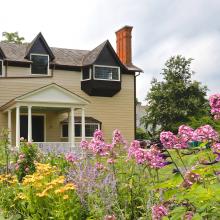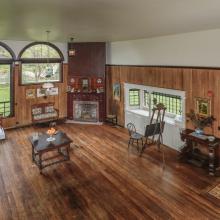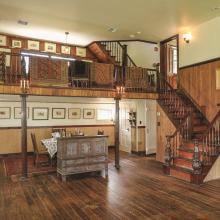
Thomas and Mary Nimmo Moran Studio
Mary Nimmo Moran, b 1842- d 1899, Thomas Moran, b 1837- d 1926229 Main Street
, East Hampton, NY 11937 - view on Google Maps
631-324-6850
631-324-6850
“In working I use my memory. This I have trained from youth, so that while sketching I impress indelibly upon my memory the features of the landscape and the combinations of coloring so that when back in the studio the watercolor will recall vividly all the striking peculiarities of the scenes visited.”
—Thomas Moran
The Studio was designed by the Morans in the Romantic Victorian cottage style with strong Queen Anne elements. There are touches of Colonial Revival and Italianate as well. There are approximately ten (10) rooms, with the studio space taking-up the vast majority of the first floor. The exterior color-palette is influenced by the aesthetic movement.
ABOUT
When visitors enter through the carved paneled double doors, the scale of the Studio immediately bursts out. The room size, the high ceilings, the huge plate-glass windows are awesome. Moran certainly planned on his workspace to overwhelm this guest. The balcony, the bay window and the antique architectural elements (he gathered in New York’s Chelsea neighborhood) add a sense of history to his construction. This assemblage brings out the artist’s environment of creativity.
The house is sighted on a rise overlooking Town Pond facing the east light. The Studio windows bring in the north light that streams in from an enormous plate glass window. Historic photographs show the three locations the artist most often worked from. Items always on view are his drafting table, a palette, bronze bust and several other small decorative items that were part of The Studio’s original furnishings.
Thomas Moran first arrived in East Hampton in early September of 1878 as a guest of the Tile Club. He is back at Montauk in July of 1879. He and Mary Nimmo Moran, an artist at the forefront of the etching revival, continue to summer in East Hampton Village until they purchase a ¾ acre lot on Main Street in 1883. Their studio/cottage is ready by September of 1884. The Morans come to East Hampton annually until Mary's untimely death in 1899 and when in 1922, Thomas Moran’s own health begins to fail. After Thomas Moran's death in 1926, his youngest daughter Ruth inherits The Studio and spends her summers there until she dies in 1948. Her sister Mary Moran Tassin sells The Studio that year to Condie Lamb. He and his wife had the property designated a National Historic Landmark in 1977. It was given to Guild Hall in 1990 (with life tenancy); an arts museum in East Hampton. The Studio was transferred to the Thomas Moran Trust in 2008 and after a lengthy restoration project opened to the public in 2018.
Thomas & Mary Nimmo Moran had three (3) children, Paul Nimmo Moran (1864-1907), Mary Scott Moran 1867-1955) and Ruth Bedford Moran (1870-1948). Also, Edward Moran’s two artist sons, Edward Percy Moran (1862-1935) and John Leon Moran (1864-1941) were often house guests. All the members of this extended family were musicians and theatrically inclined. The Studio was often used for dances and performances. The specialty of the family were Tableau Vivants, which were often preformed from the front porch of The Studio. They also brought back a gondola, in 1889, from Venice and were often seen enjoying a ride on Hook Pond on summer evenings. The gondolier was always appropriately costumed.
One summer, Town Pond (directly across the street from The Studio) went almost dry, leaving a stinky mess. Moran got permission from the Town of East Hampton to run a hose across Main Street and pump water from his well, into the muddy pond bed. He kept the pond looking pretty and eliminated to stench.
The Moran family was very socially inclined. They were founding members of St. Luke’s Episcopal Church and the Maidstone Club. They supported many community events and often orchestrated fund-razing programs for the purchase of library books or buying a watering cart to keep the dust down on Main Street. Daughter Ruth was a member of the Guild Hall Players, preformed at the annual summer L.V.I.S. Fair as a gypsy fortune teller. There exists an original watercolor poster by Thomas Moran, for his daughter Ruth’s summer poetry readings.
Since Moran’s training (by his brother Edward) was academy-oriented, his collection of several thousand drawings and watercolor sketches were the foundation for this finished oils and watercolors. Since he worked from these sketches, he could paint any scene, anytime, anywhere. We know that the great “Specters from the North” was painted in East Hampton. He used the work’s first showing at Clinton Hall for local fundraising. Many of his East Hampton subjects were certainly conceived and painted here. Almost all his East End etching plates were created here in the Village.
Thomas Moran first arrived in East Hampton in early September of 1878 as a guest of the Tile Club. He is back at Montauk in July of 1879. He and Mary Nimmo Moran, an artist at the forefront of the etching revival, continue to summer in East Hampton Village until they purchase a ¾ acre lot on Main Street in 1883. Their studio/cottage is ready by September of 1884. The Morans come to East Hampton annually until Mary's untimely death in 1899 and when in 1922, Thomas Moran’s own health begins to fail. After Thomas Moran's death in 1926, his youngest daughter Ruth inherits The Studio and spends her summers there until she dies in 1948. Her sister Mary Moran Tassin sells The Studio that year to Condie Lamb. He and his wife had the property designated a National Historic Landmark in 1977. It was given to Guild Hall in 1990 (with life tenancy); an arts museum in East Hampton. The Studio was transferred to the Thomas Moran Trust in 2008 and after a lengthy restoration project opened to the public in 2018.
Thomas & Mary Nimmo Moran had three (3) children, Paul Nimmo Moran (1864-1907), Mary Scott Moran 1867-1955) and Ruth Bedford Moran (1870-1948). Also, Edward Moran’s two artist sons, Edward Percy Moran (1862-1935) and John Leon Moran (1864-1941) were often house guests. All the members of this extended family were musicians and theatrically inclined. The Studio was often used for dances and performances. The specialty of the family were Tableau Vivants, which were often preformed from the front porch of The Studio. They also brought back a gondola, in 1889, from Venice and were often seen enjoying a ride on Hook Pond on summer evenings. The gondolier was always appropriately costumed.
One summer, Town Pond (directly across the street from The Studio) went almost dry, leaving a stinky mess. Moran got permission from the Town of East Hampton to run a hose across Main Street and pump water from his well, into the muddy pond bed. He kept the pond looking pretty and eliminated to stench.
The Moran family was very socially inclined. They were founding members of St. Luke’s Episcopal Church and the Maidstone Club. They supported many community events and often orchestrated fund-razing programs for the purchase of library books or buying a watering cart to keep the dust down on Main Street. Daughter Ruth was a member of the Guild Hall Players, preformed at the annual summer L.V.I.S. Fair as a gypsy fortune teller. There exists an original watercolor poster by Thomas Moran, for his daughter Ruth’s summer poetry readings.
Since Moran’s training (by his brother Edward) was academy-oriented, his collection of several thousand drawings and watercolor sketches were the foundation for this finished oils and watercolors. Since he worked from these sketches, he could paint any scene, anytime, anywhere. We know that the great “Specters from the North” was painted in East Hampton. He used the work’s first showing at Clinton Hall for local fundraising. Many of his East Hampton subjects were certainly conceived and painted here. Almost all his East End etching plates were created here in the Village.
Did you know...?
Mary Nimmo Moran once took several neighborhood children out in a boat on Hook Pond and let them each incise a blade of cattail onto her copper etching plate.SPECIAL RESOURCES
The site owns collections of both Thomas & Mary Nimmo Moran’s paintings and etchings, plus works by other members of the Moran Family. There were eighteen (18) artists in three generations of the family starting with Edward Moran (1829-1901).view on Google Maps
NEARBY SITES
WHAT TO DO HERE
- Take a Guided House Tour
- Stroll on a Tour of the Gardens
- Celebrate during Victorian Christmas tours and afternoon teas
- Listen at one of the Poetry and Victorian literature readings
- Attend a musical ensemble event
- Enjoy Special Curator tours
- Learn about art at one of the site's exhibitions
- Participate in a workshop
YOU CAN ALSO SEE THE ART HERE:
- The National Gallery of Art
- Metropolitan Museum of Art
- Museum of the City of New York
- National Academy of Design
- The Chrysler Museum of Art
- New Britain Museum of American Art
- Gilcrease Museum of Oklahoma University
- Yellowstone National Park
- Smithsonian American Art Museum
- Heckscher Museum of Art
- The Nelson-Atkins Museum of Art
- The White House









